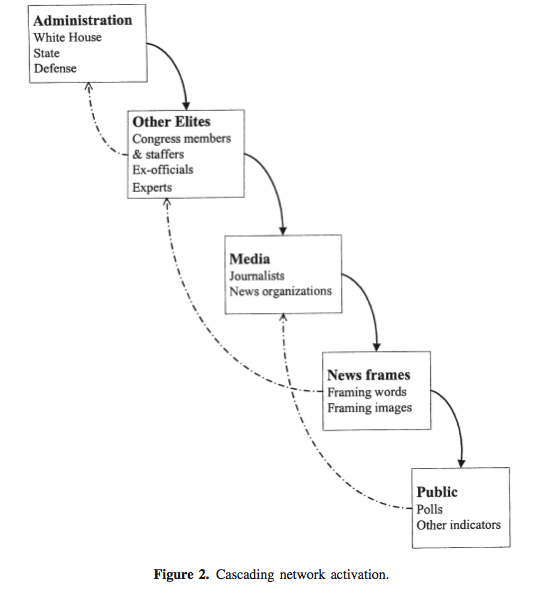Jamieson doesn't use the terminology but what her points are very similar to priming and framing of agenda-setting theories. Media chooses how to frame an issue and what to report as background information in the issue. Practically by giving background information, media makes some knowledge available once again. But still, who controls these priming and framing processes? Journalists? If so, is it too late for me to become a journalist? Politicians? Public? Anyone?
Especially in political context, Entman's Cascading Activation model seems to be very accurate in explaining - well first of all explaining that the process is practically inexplicable - the behavioral patterns of different social actors and their power struggles. The figure below is taken from one of his published articles about White House's frame following 9/11 - illustrating the cascading flow of influence linking each level of the system: the administration, nonadministration elites, news organizations, the texts they produce, and the public (p.419).

Similar to a real waterfall, all the actors include their own input to the flow. I interpret this input to be composed of their own interests and ideas. Therefore, the information that reaches the public has already been 'polluted' a few times. There seems to be a power struggle over who will influence the priming and framing in this process. And the back-flow underlines the fact that public opinion is likely to show an impact on the media, as well as on administration and non-administrative elites.
I assume if we try to apply this model to place/nation branding, the flow chart will be a little bit different:

Branding campaigns should take competitors and other news resources into consideration. Several nations/regions/places try to reach the same audiences with practically similar messages. There might be other news resources feeding the media, such as other interest groups or negative branding campaigns of your competitors or a more 'news-worthy' event. Also, although relevant stakeholders will be included in the process, it is always possible to leave certain influential figures out. Their actions will be based on personal interest which might or might not be compatible with the main branding campaign.
Another important distinction is the possibility of creating communication bridges directly with the public. However, public is likely to disregard the messages if the sender lacks credibility. Also, if the stakeholders and officials are not 'accountable', they are more likely to disregard the messages.
To sum up, media-public opinion relations is very difficult to entirely comprehend, especially in a political context. Given the vague definitions and lack of strong theoretical frameworks in nation/place branding, it is even more tricky. I was amazed by Entman's Cascading Activation Model and came up with a draft of how this model might look like in branding campaigns. As this is a draft model, I would appreciate your feedback! . I will be constantly updating this blog post based on the feedback I receive and (hopefully) come up with a better model.
No comments:
Post a Comment